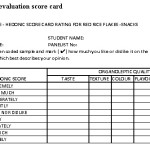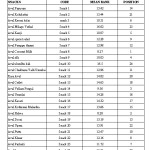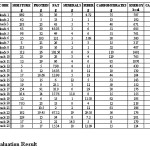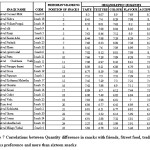Introduction
Snacks are small portion for a quick meal which can be consumed by children, adolescent, adults and senior citizens to enable them to satisfy their hunger between lunch and dinner.
Snack can be termed for a small portion, light and quickly consumable food or drink; it is consumed between the regular meals.1 Eating healthy snacks fuels the body with energy, improves the brain power, regulates weight management, boosts up mood and makes the day pleasant.2 Our Indian traditional foods have been recognized as functional foods due to the presence of body healing chemicals, dietary fibres, high vitamins and mineral constituents. Adolescents consume more snacks than other age groups. Nowadays our healthy traditional snacks have been overwhelmed by modern westernized junks. These junk snacks constitute mere sugar, fat and calories which act as the origin for all major health problems.3 Consuming these unhealthy junks makes the adolescent to skip their regular meals,4 overeating and inactive life styles leads to overweight and obesity.5
Thus the study is an attempt to bring out traditional snacks into practice. The study formulates recipes of red flattened rice, the common healthy snacks. Red flattened rice is a wholesome food with high nutritious value and easily digestible form of rice variety commonly available across India. It is used to prepare light snacks and fast food varieties and consumed as a staple breakfast in north – eastern regions. Making of Red rice flakes constitutes a procedure of soaking the paddy for few days where a partial fermentation is done and the probiotic bacteria are developed5 then boiled, dried and pounded to loosens the hull from the paddy and makes it into a flattened rice flakes.6
Originally our ancestors had a strong faith that food was a gift from God and this food was consumed for its health benefits. Man in every community followed a separate food belief system. Additionally food had spiritual values. In India it has been included plain or with other dishes as an offering to their God and Goddess especially for Lord Murugan during Karthigai Deepam, Lord Krishna during Krishna Jayanthi. Many recipes have been made with flattened red rice flakes like uppuma, payasam, puttu, masala urundai, kolakatai etc. The oryza sativa ( red rice) flakes is renowned for its very healthy and nutritionally strong benefits. They were highly recommended and consumed by our ancestors. Flattened rice sweetened with jaggery are still consumed in villages of Tamil Nadu,
Red rice flake is unpolished so it is rich in carbohydrates (86.22g). A 100gm of flakes consist of minerals like sodium (763 mg), potassium (110mg), Protein (6.69g) Iron (5.5 mg) and also rich in Vitamin A and Vitamin C.7 Red rice flakes are gluten and cholesterol free hence can be consumed by diabetics as an alternative to wheat. The antioxidant present in the unpolished husk of red rice flakes improves metabolism and prevents colon cancer.8 The Magnesium and other minerals present in red rice improve the bone strength, fights against asthma and reduces the risk of obesity.9
The Objective of the Study
To incorporate the Indian Snacks with oryza sativa (red rice) flakes. Ranking the preference of red rice incorporated snacks among the adolescents. To highlight the importance and nutritive value of incorporated snacks. Snack recipes are incorporated with the red rice flakes. Sensory evaluation of organoletic qualities are analysed for the recipes.
Materials and Methods
The study comprises of developing Indian snack with selected recipes suitable for adolescents were incorporated with the red rice flakes. Recipes selected were the most commonly consumed and preferred by the adolescent age group.
Twenty five recipes were carefully selected to meet the pattern of consumption, health benefits and the preferences of the adolescents. The incorporation of recipes with red rice flakes were done and among the twenty five recipes fifteen recipes were selected, the criteria of selection were easy to prepare, constituting inexpensive and commonly available ingredients, nutritive in nature and acceptable preference by adolescents.
Collection of Ingredients
The ingredients for the recipes were bought from market and organic stores in and around Pallavaram Chennai. The quality of ingredients is inspected and considered for the best outcome of the products.
Preparation of Recipes
The recipes are prepared under their authentic methods of preparation; all recipes are formulated with the incorporation of oryza sativa (red rice) flakes as per the required proportions. The recipes were standardized and prepared at Advanced Training Kitchen in School of Hotel and Catering Management, Vels University under the guidance of Chef in charge by the final year students.
Table 1: Snacks with their Code
| S. NO | NAME OF THE SNACKS | CODE |
| 1 | Aval Payasam | SNACK 1 |
| 2 | Aval Kolukattai | SNACK 2 |
| 3 | Aval Keerai Adai | SNACK 3 |
| 4 | Aval Milagu Vathal | SNACK 4 |
| 5 | Aval Kanji | SNACK 5 |
| 6 | Aval sprout salad | SNACK 6 |
| 7 | Aval Paruppu thanni | SNACK 7 |
| 8 | Aval Coconut Milk | SNACK 8 |
| 9 | Aval idli | SNACK 9 |
| 10 | Aval ulundhu kali | SNACK 10 |
| 11 | Aval Chakkarai Valli Urundai | SNACK 11 |
| 12 | Kara Aval | SNACK 12 |
| 13 | Aval Cutlet | SNACK 13 |
| 14 | Aval Vellam Pongal | SNACK 14 |
| 15 | Aval Urundai | SNACK 15 |
| 16 | Aval Kesari | SNACK 16 |
| 17 | Aval kothumai Maleetha | SNACK 17 |
| 18 | Aval Halwa | SNACK 18 |
| 19 | Aval Dosai | SNACK 19 |
| 20 | Aval Upma | SNACK 20 |
| 21 | Aval Puttu | SNACK 21 |
| 22 | Aval Kheer | SNACK 22 |
| 23 | Aval Pachadi | SNACK 23 |
| 24 | Aval Somas | SNACK 24 |
| 25 | Aval Vada | SNACK 25 |
Sensory Evaluation of Recipes
All the twenty five recipes are coded as SNACK 1 to SNACK 25 respectively; names of the recipes and their ingredient composition were not disclosed to the panellist members. The panel consist of 50 students as members from Departments of Biochemistry, Engineering, Visual Communication, and Hotel & Catering Management at Vels University pursing their under graduation. The age group and their own interest in participation to taste food were considered as the criteria in selecting the panellist members.
The panellist members were groups into ten and five snacks were served to a group per day at a perfect interval of time for the best output of result, hereby the evaluation was carried out for five days for all five groups to evaluate all twenty five snack varieties. The panellists were provided with the sensory evaluation (Table 2) score card to mark their score for the snacks served. The score ranges from 1- Dislike Extremely to 9- Like Extremely evaluating the organoleptic qualities of the snacks including the parameters like taste, texture, colour, flavour, and their acceptance of the snacks.
 |
Table 2: Sensory evaluation score card Click here to View table |
Statistical Analysis
All the recipes were incorporated with oryza sativa (red rice) flakes and served to the adolescents. This study selected the students as the panellist members so the opinion from the adolescent were collected through the sensory evaluation score card. The data collected are statistically analysed using the SPSS (21.0) software, initially the data are checked for their reliability. Upon the overall acceptance by the panellist the snacks are ranked using Friedman’s ranking test, the test used to ranks a group with lesser number of variables.10
Evaluation of Nutritive value
Upon the preference ranking by the adolescents the snack taken the first ten positions are considered and their nutritive values are calculated using the book titled Nutritive Value of Indian Foods published by National Institute of Nutrition, ICMR published in the year 2015.
Result and Discussions
Sensory evaluation data were analysed using the SPSS (21.0) software, the data collected from the panellist are reliable (Table 3) with the Cronbach’s Alpha value 0.782.
Table 3: Reliability test
| No of items | N | Cronbach’s Alpha |
| 25 | 50 | 0.782 |
Friedman’s Test
Friedman’s test is done to find out the ranking position of the twenty five dishes overall acceptance among the panelist. The organoleptic qualities of the twenty fives recipes were collected through the score data. Table 4(a) and Table 4(b) exhibit the raking of preferences of the snacks by the panellist members. Since the p value is 0.000 is less than 0.05 (p<0.01), there is a significant difference in the ranking of the rice flakes newly standardized recipes.
It is concluded that the panelist of Vels University have ranked the sensory evaluation of the twenty rice flakes recipes in a significantly different manner. Out of the twenty five recipes considered for analysis, Aval Coconut Milk has the lowest mean rank, followed by Aval Halwa and Aval Vellam Ponagal. Hence, it is concluded that the Aval Coconut Milk recipe is the most desired dish out of the twenty five standardized recipes.
The ranking positions are more significant (p- value is .000) and the value of chi-square value (167.524) is high.
 |
Table 3 a Click here to View table |
| Table 4 (b) Test Statisticsa | |
| N | 50 |
| Chi-Square | 167.524 |
| Df | 24 |
| Asymp. Sig. | .000 |
| a. Friedman Test | |
 |
Table 5: Nutritive Values of the Snacks Click here to View table |
The nutritive value of snacks is briefly exhibited in Table 5. It is prominent in the table that among the twenty five snacks recipe’s nutritive values, selected recipes are discussed with special references to the high nutritive content in the snacks. The snack 6 is high in protein, snack 9 contains energy, snack 22 is rich in calcium, snack 3 is high in phosphorous and snack 4 is contains iron. Thus the snacks incorporated with red rice flakes are more nutritive and meeting the requirements of the adolescents.
 |
Table 6: Sensory Evaluation Result Click here to View table |
Table 7: Correlations between Quantity difference in snacks with friends, Street food, traditional snacks preference and more than sixteen snacks
| Snacks consumption increases being with friends | Street foodconsumption | ||
| Snacks consumption increases being with friends | Pearson Correlation | 1 | 0.336 |
| Sig(2 – tailed) | 0.05 | ||
| Street foodconsumption | Pearson Correlation | 0.336 | 1 |
| Sig(2 – tailed) | 0.05 | ||
| ** Correlation is significant at the 0.05(2tailed) | |||
Table 7 shows that there is a linear positive correlation between Quantity difference with friends and Street food consumption among the students. The correlation coefficient is 336 and it is statistically significant as a p value is lesser than 0.05. It is understood from the analysis that the adolescents consumption of street food is very much on the higher side when they are with their friends.
Table 8: Correlations between Traditional snacks preference and more than sixteen snacks
| Traditional Snack preference | Prefers more than 16 snacks incorporated with rice flakes | ||
| Traditional Snack preference | Pearson Correlation | 1 | 0.489 |
| Sig(2 – tailed) | 0.00 | ||
| Prefers more than 16 snacks incorporated with rice flakes | Pearson Correlation | 0.489 | 1 |
| Sig(2 – tailed) | 0.00 | ||
| *Correlation is significant at the 0.00(2-tailed) level | |||
Table 8 shows that the Traditional snacks preference and liked more than sixteen snacks among the students are positively correlated and correlation co efficient .489 it is statistically significant ( p<.05). There is positive correlation between Traditional snacks preference and liked more than sixteen snacks. The consumption of snacks quantity is positively correlated with street food consumption at (r = 0.336, p <0.05).
Among the students the Traditional snacks preference is positively correlated with students liking more than sixteen snacks at (r = 0 .489, p<0.05).The result exhibits that all constructs used to measure the students preferences to traditional snacks are associated and the correlation is significant at 0.05 level.
Conclusion
There is to a great extent of diversity in traditional healthy snacks in India because the regional healthy foods have originally evolved suitable to the climate, traditions, and cultivation practices of the individual state.
Additionally, certain foods have become more popular in certain state according to the health condition of a population.
This study confirms that the healthy nutrients of the oryza sativa (red rice) flakes is gluten free, it provides immediate energy to our system, improves the bowel movements and stabilizes the blood sugar level. Additionally it provides essential source of B1 vitamin to our human body. Red rice flakes prevents primary and secondary coronary disease, allergies, aids in digestion preventing constipation among adolescents.
This study concludes that the snacks incorporated with red rice flakes are considerable preferred by the adolescents for their freshness and nutritive values. More traditional ingredients can be incorporated into the daily meal pattern can reduce the consumption of junk and preserved food among the adolescents making a healthy generations.
Acknowledgements
We would like to mention our sincere gratitude towards our Head of the Department Mr. R. Bennet (HCM) department for giving us opportunity to carry out our research lab work.
Funding Source
Nil
Conflict of Interest
Nil
References
- Lisa Baertlein. Healthy Snacking Benefits. [Updated on 02nd February 2016. Cited on 3rd March 2017] Available at: http://www.everydayhealth.com/diet-nutrition/meal-planning/healthy-snacking-benefits.aspx
- Ashakiran & Deepthi R. Fast Foods and their Impact on Health. JKIMSU. 2012;1(2). ISSN 2231-4261
- Savige G, MacFarlane A, Ball K, Worsley A, Crawford D. Snacking behaviours of adolescents and their association with skipping meals. The International Journal of Behavioral Nutrition and Physical Activity. 2007;4:36. doi:10.1186/1479-5868-4-36.
CrossRef - Kushner, R. F. and Choi, S. W. Prevalence of Unhealthy Lifestyle Patterns Among Overweight and Obese Adults. Obesity. 2010;18:1160–1167. doi:10.1038/oby.2009.376
CrossRef - Anupama. Red poha diabetes friendly [September 9, 2015] [Cited on 2nd March 2017] Available at: http://easybitesonline.com/red-poha-diabetes-friendly/
- Grains Go Gourmet – [Cited on 2nd March 2017] Available at: http://epaper.timesofindia.com/Default/Scripting/ArticleWin.asp?From=Archive&Source=Page&Skin=ETNEW&BaseHref=ETD%2F2011%2F04%2F01&PageLabel=36&EntityId=Ar03600&AppName=1&ViewMode=HTML
- Rice Flakes. Fat Secret. [Cited on 3rd March 2017] Available at: https://www.fatsecret.com /calories-nutrition/generic/rice-flakes?portionid=53413&portionamount=100.000
- Gani A, Wani SM, Masoodi FA, Hameed G (2012) Whole-Grain Cereal Bioactive Compounds and Their Health Benefits: A Review. J Food Process Technol 3:146. doi:10.4172/2157-7110.1000146
CrossRef - Health benefits of Red Rice. [cited on 3rd February 2017] available at: https://www.healthbenefitstimes.com/health-benefits-of-red-rice
- Hua Zhang, Guogen Shan, Daniel Young. Comparison of unweighted and weighted rank based tests for an ordered alternative in randomized complete block designs. Communications in Statistics – Simulation and Computation. 2017;46:6:4452-4464.
CrossRef

This work is licensed under a Creative Commons Attribution 4.0 International License.





